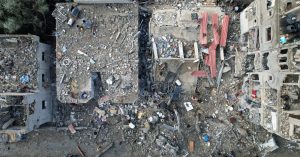
The Israeli military admitted that they were responsible for two deaths in Central Gaza
On the status of an Egyptian proposal to end the current war on Hamas and the West Bank, Gaza, and the question of future governance
A revised Egyptian proposal to end fighting in Gaza calls for an extension of a humanitarian cease-fire and leaves the question of future governance of the West Bank and Gaza Strip open.
Israel’s war on Hamas has forced many of Gaza’s 2.3 million Palestinians to repeatedly flee for their lives as airstrikes bombard their towns and cities and Israeli forces advance their ground invasion.
Israel’s war cabinet discussed the Egyptian proposal late Monday, after it was reported on by several news organizations, which adds to the public pressure Israel faces to end the current phase of the war.
In the first stage, lasting 10 days, there would be a complete cessation of hostilities by both Israel and Hamas. Hamas would release all civilians in its possession and Israel would release a mutually agreed-upon number of Palestinian prisoners. Israeli forces would withdraw from residential areas in Gaza and allow freedom of movement for citizens from south to north, as well as the movement of vehicles and trucks. It would allow for humanitarian aid, including medicine, fuel and food to all areas of Gaza.
It is unclear if Israel is willing to negotiate based on this proposal. Previous negotiations have been led by Qatar, which helped broker a week-long cease-fire in late November that led to the exchange of 105 hostages held by Hamas for some 240 Palestinians in Israeli jails.
That part of the plan has been dropped from the latest two-page version of the proposal, but the future Palestinian leadership was expected to be discussed in talks with Egypt and is expected to be a crucial part of any agreement.
Hamas did not reject the latest proposal completely, but it did acknowledge that it has received some ideas from other countries for a permanent truce.
The militant group said that the people did not want to wait for temporary truces that the occupation would violate with more massacres and war crimes.
The humanitarian crisis in Gaza, the U.N. humanitarian agency and Gaza’s civilians: Israeli forces forced to flee, says Juliette Touma
As Gaza recovered from another communications blackout, the latest diplomatic efforts took place. The primary provider in the area claims that cell phone and internet service had been out for a long time. On Tuesday night, the telecommunications company announced that they had service interruption due to damaged infrastructure.
Some 1.9 million people in Gaza, or nearly 85 percent of the population, are estimated to be displaced, according to the U.N. relief agency for Palestinians.
Speaking to NPR’s Morning Edition on Tuesday, Juliette Touma, a spokesperson for UNRWA, the U.N. relief agency focused on the Palestinian situation in Gaza, said the humanitarian situation in Gaza was becoming more dire by the moment.
“Now, with the rainy season, it’s everything from warm clothes to blankets. The most urgent needs are food and water, said Touma.
“They threatened the entire block around us, even the new camp, even the market street — all of it they threatened,” she said. “They dropped leaflets ordering us to leave within three days. We had to come here.
The mother of five was at the Aqsa Hospital in Deir al-Balah with 20 members of her extended family. Since the war began, the family has been forced to flee four times.
According to an analysis of the visual evidence by The New York Times, Israel has been using 2,000-pound bombs in densely populated parts of southern Gaza where civilians were told to move for safety.
The agency said it was forced to move again. “Evacuation order by Israeli authorities of middle Gaza causes ongoing forced displacement. There are 150,000 people unable to go, including young children, women carrying babies, people with disabilities and the elderly.
The last time they were displaced was said to be this time. The family lost everything the first time it fled, he said.
Israel ordered people to move to shelters that can only hold a few hundred thousand people.
The United States voiced its concerns about the humanitarian issues. A military spokesman said on social media that the maps were published in order to preserve the security and safety of the Gazans.
They settled in a tent in the nearby Nuseirat area, where tens of thousands of Palestinians forced by Israel’s air and ground offensive had also fled and were finding what shelter they could in overcrowded schools, ramshackle tents or even out in the streets.
Under intense Israeli strikes, a number of family members were killed, including an uncle and a brother, when they fled their home in the central Gaza Strip.

